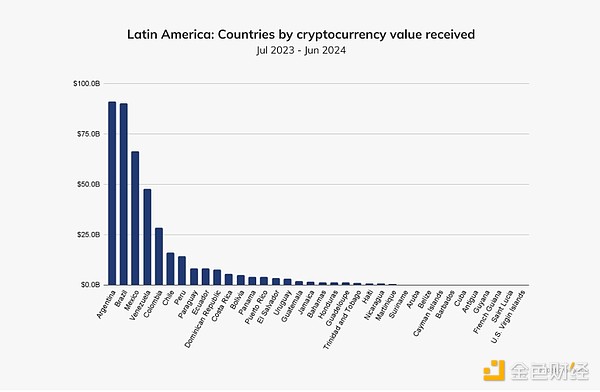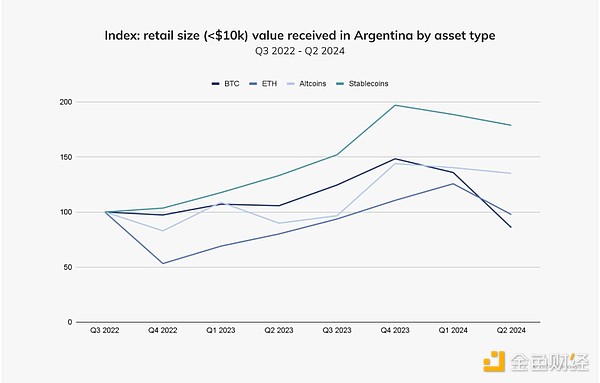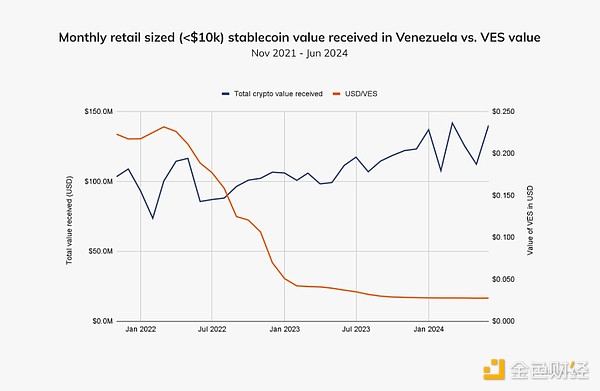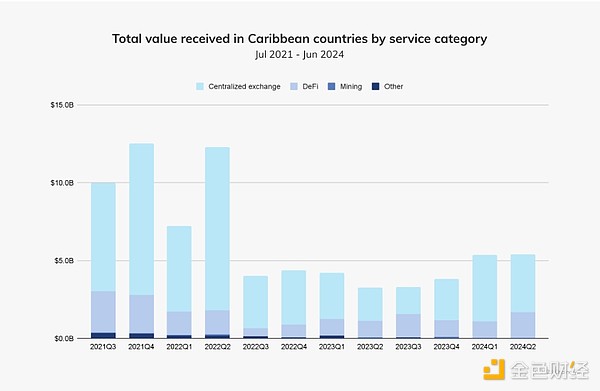Source: Chainalysis; Compiled by: Deng Tong, Golden Finance
Latin America is the fifth largest region in our study, accounting for 9.1% of the value of cryptocurrencies received between July 2023 and June 2024. During this period, the region received nearly $415 billion in cryptocurrencies, slightly more than East Asia.


Centralized exchanges (CEXs) are the most commonly used service by Latin Americans, accounting for 68.7% - slightly lower than the CEX usage rate in North America. Regional deal value in Latin America was driven primarily by institutional and professional investors (i.e. entities with transactions exceeding $10,000).


Latin America was the second fastest growing region in our research this year, with a year-over-year growth rate of approximately 42.5%. As we’ll explore later, much of this growth has been driven by strong but diverse cryptocurrency markets in Venezuela, Argentina, and Brazil.

Argentina tops the region in terms of cryptocurrency value, with an estimated $91.1 billion, just ahead of Brazil’s $90.3 billion.

Four of the top 20 countries in our Global Adoption Index are in Latin America: Brazil (9), Mexico (13), Venezuela (14), and Argentina (15). As we’ll explore in more detail below, stablecoin-based remittances are growing in popularity in these countries and across Latin America.

Institutional Cryptocurrency Activity in Brazil Suggests Renewed Interest from Major Financial Institutions
In last year’s Geos report, we noted that while Brazil has historically had a developed institutional cryptocurrency market, institutional activity declined in early 2023, which likely coincided with the global cryptocurrency bear market. But the trend reversed in the middle of this year and has increased since then, indicating renewed interest from major financial entities. For example, the monthly value of institutional-sized transactions (i.e., over $1 million) increased by approximately 29.2% between the last two quarters of 2023, and by approximately 48.4% between the fourth quarter of 2023 and the first quarter of 2024.

We spoke to André Portilho, head of digital assets at investment bank BTG Pactual, to learn more about what’s driving this institutional activity. "A key factor is portfolio diversification, especially as the market matures. Investors are increasingly incorporating digital assets into their asset allocation strategies, viewing them as valuable alternative investments with the potential to enhance returns. The integration of Bitcoin and other cryptocurrencies as established investment options is critical in this shift," he explained. "The notable resurgence in institutional activity in crypto assets in Brazil can be attributed in part to the evolution of regulation and the entry of U.S. institutions into the cryptocurrency market, particularly with the launch of Bitcoin and Ethereum ETFs."
Aaron Stanley, founder of Brazil Crypto Report, a newsletter and podcast exploring the latest trends in the Brazilian crypto ecosystem, noted a similar trend in Brazil embracing crypto. "The ecosystem is already fairly mature. We have seen several TradFi banks launch crypto brokerage products (e.g., the country’s largest bank, Itaú), and most other major banks are actively building similar products of their own. We saw major global exchanges like OKX and Coinbase struggle to launch in the country, complete with local teams and entities. The pilot program for Drex, a hybrid CBDC/smart contract platform being developed by the Brazilian central bank, has also prompted TradFi banks to be more forward-thinking in their digital asset strategies. This has had downstream benefits for these institutions and their clients in terms of crypto adoption."
With cryptocurrency activity booming in Brazil, we conducted a detailed analysis of the most popular assets among Brazilians. First, we found that Bitcoin trading grew the most during the study period. A particularly sharp increase in Bitcoin trading value was seen between September 2023 and March 2024, which could coincide with the SEC’s approval of a spot Bitcoin ETF in January 2024. It is also worth noting that the price of Bitcoin nearly doubled during this period, which could have contributed to these higher volumes.

A closer look at this Bitcoin activity shows that Brazilians are receiving much higher values on global exchanges than on regional local exchanges.

However, on local exchanges, there is a stark contrast in the types of assets traded. As shown below, stablecoin trading volume on local exchanges has grown significantly more year-over-year (207.7%) than Bitcoin, Ethereum, and altcoins. Stanley noted that “many exchanges and fintech brokerages in Brazil offer stablecoins pegged to the US dollar to their clients, with the idea being to provide exposure to the US dollar as a store of value. This has certainly attracted attention, but at this stage, the main use case for stablecoins seems to be in B2B cross-border payments.”

Currently, stablecoins account for about 70% of indirect flows from local Brazilian exchanges to global exchanges. Brazil’s high level of stablecoin activity and general interest in digital products and services has attracted significant interest from major cryptocurrency players, notably Circle, which announced an official launch in Brazil in May 2024. A Circle spokesperson said, “Circle’s involvement in Brazil’s regulatory certainty has increased due to policies and initiatives that encourage innovation, and more business-friendly rules are expected in the near future. We are working with leading regional businesses to launch digital asset products, provide Brazilian users with near-instant, low-cost, 24/7 access to USDC, and strengthen our local operations to reach a wider user base. As a result of the commitment to the region and existing partnerships, the number of users in the region transacting with USDC has grown exponentially.”

So what does the future hold for Brazil’s evolving cryptocurrency landscape? As Stanley pointed out, Brazil’s overall economy may still pose a barrier to mainstream adoption. "Economic growth has slowed; the Brazilian real (BRL) has depreciated significantly against the dollar this year; and there are concerns that taxes will continue to increase. Middle-class consumers and households face a huge debt burden. In short, there is not as much disposable income as one would expect in such a vast country." However, there are still opportunities for cryptocurrency growth, especially if regulators are open-minded about the technology. "They see it as a tool to be exploited rather than a threat to be suppressed. A regulatory regime that is well-received by the market should provide a stable foundation for the crypto economy in the coming years," Stanley concluded.
Stablecoins Offer a Path to Stability During Argentina's Long Economic Turmoil
Argentina's decades-long battle with inflation and the devaluation of the Argentine Peso (ARS) has left many citizens looking for alternatives to protect their savings and ensure a more stable economic future. Unfortunately, Argentina's economic situation has been particularly shaky this year. With inflation at around 143% by the second half of 2023, the value of the Argentine rupee has fallen sharply, and four in ten Argentines live in poverty. In December 2023, newly elected President Javier Mire announced a 50% devaluation of the Argentine rupee, which he described as “shock therapy,” and that the government would cut energy and transportation subsidies.
To protect themselves from the impact of this economic crisis, some Argentines have turned to the black market to buy foreign currency, most commonly the U.S. dollar (USD). This “blue dollar” is a U.S. dollar that trades at a parallel, informal exchange rate and is often purchased through clandestine exchange offices called “cuevas” across the country. Others have explored stablecoins pegged to the U.S. dollar, which is reflected in our data.
We looked at monthly stablecoin trading volumes for ARS on Bitso, Latin America’s leading regional exchange, and found that the devaluation of the peso has consistently triggered an increase in monthly stablecoin trading. For example, when the value of ARS fell below $0.004 in July 2023, monthly stablecoin trading surged to over $1 million the following month. Likewise, when the value of ARS fell below $0.002 in December 2023 (announced by President Milei), the value of stablecoin transactions exceeded $10 million the following month.

Not surprisingly, Argentina’s stablecoin market leads the Latin American region. Argentina’s stablecoin trading volume share is 61.8%, slightly higher than Brazil’s share (59.8%) and well above the global average (44.7%).

In addition, the value of retail-scale stablecoins received in Argentina (i.e., transactions under $10,000) has grown faster than the value of any other asset type, again suggesting that Argentines view stablecoins as a means to mitigate the effects of inflation and currency depreciation. Their interest in stablecoins highlights the role of cryptocurrencies in volatile markets and how citizens can better control their financial future by accepting cryptocurrencies, regardless of official monetary policy.

Despite uncertainty over Maduro regime, Venezuela’s cryptocurrency adoption remains strong
Venezuela’s relationship with cryptocurrency has been turbulent, marked by experiments such as the launch (2018) and subsequent abrupt termination (2024) of the state-backed Petro (PTR), a stablecoin backed by Venezuela’s oil and mineral wealth, as well as a crackdown on Bitcoin mining and blocking access to certain major cryptocurrency exchanges. Meanwhile, as the Maduro regime seeks ways to circumvent economic sanctions, its illicit oil trade has become entangled with cryptocurrency transactions, leading to high-profile prosecutions by the U.S. Department of Justice. These cryptocurrency-related events highlight a broader shift toward the Maduro regime using it as a weapon of corruption and citizens using it as a means to ensure financial independence.
However, despite this unrest, the Maduro regime has recently hinted at a renewed interest in cryptocurrencies, but has offered no concrete plans. Regardless of the outcome of such political developments, Venezuela remains one of the fastest-growing cryptocurrency markets in Latin America. Venezuela’s 110% year-over-year growth far exceeds any other country in the region.

What’s driving this growth? First, Venezuelans appear to be drawn to cryptocurrencies in response to the plunge in the Venezuelan Bolivar (VES). As shown below, there is a strong inverse relationship between the price of VES in U.S. dollars and the value of cryptocurrency received each month. This is corroborated by a number of media reports, indicating that ordinary Venezuelans continue to seek a stable store of value and hedge against the country's economic crisis.

DeFi is another aspect of cryptocurrency growth in Venezuela. Since 2022, centralized services have accounted for the majority of the value received in the country. However, there has been a growing interest in DeFi, which was particularly evident in late 2023.

While centralized services remain the most popular so far this year, DeFi’s growing market share will be an area to watch in the country in the near future, and this growth could accelerate further if the Maduro regime clearly supports cryptocurrency innovation.
Cryptocurrency activity in the Caribbean accelerates after FTX collapse
In the years following the collapse of FTX, the Caribbean crypto ecosystem experienced a period of uncertainty and activity slowed as trust in crypto platforms waned. However, starting in late 2023, the Caribbean region witnessed a resurgence in cryptocurrency activity. Users appear to be moving to mainstream centralized exchanges (CEXs) such as Coinbase and Binance.

We spoke to David Templeman, a professional financial investigator at the Cayman Islands Financial Investigation Bureau, to learn more about how cryptocurrency activity is changing in the Caribbean. Specifically, in the Cayman Islands, Templeman noted that “the number of offshore clients seeking to establish legal entities in the Web3 and blockchain space has increased significantly over the last year compared to recent years. These projects typically include either Layer 1 or Layer 2 and have a wide range of applications, from AI, cross-chain infrastructure, gaming, and data/cloud storage.”
As Templeman concluded, “The fallout from the various debacles (FTX, TerraUSD/Luna, Celsius Network, and Three Arrows Capital) has put pressure on the industry to learn from its mistakes and put in place better oversight and guardrails. The islands have a strong community of blockchain and Web3 companies that are both physically present and legally registered here.” Cryptocurrency activity in the Caribbean appears to be booming once again, solidifying the sub-region’s position as a key hub for adoption in the coming years.
 Kikyo
Kikyo
 Kikyo
Kikyo Joy
Joy Alex
Alex Alex
Alex Joy
Joy Alex
Alex Joy
Joy Joy
Joy Brian
Brian Kikyo
Kikyo